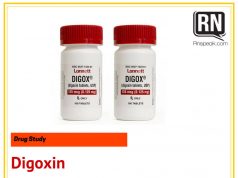Generic Name: Piperacillin/Tazobactam
Brand Name:Zosyn
Classifications: antiinfective; beta-lactam antibiotic; antipseudomonal penicillin
Pregnancy Category: B
Availability 2 g, 3 g, 4 g injection
Actions
Antibacterial combination product consisting of the semisynthetic piperacillin and the beta-lactamase inhibitor tazobactam. Tazobactam component does not decrease the activity of the piperacillin component against susceptible organisms.
Therapeutic Effects
Tazobactam is an inhibitor of a wide variety of bacterial beta–lactamases. It has little antibacterial activity itself; however, in combination with piperacillin, it extends the spectrum of bacteria that are susceptible to piperacillin. Two-drug combination has antibiotic activity against an extremely broad spectrum of gram-positive, gram-negative and anaerobic bacteria.
Uses
Treatment of moderate to severe appendicitis, uncomplicated and complicated skin and skin structure infections, endometritis, pelvic inflammatory disease, or nosocomial or community-acquired pneumonia caused by piperacillin-resistant, piperacillin/tazobactam-susceptible, beta-lactamase-producing bacteria.
Contraindications
Hypersensitivity to piperacillin, tazobactam, penicillins, cephalosporins, or beta-lactamase inhibitors such as clavulanic acid and sulbactam.
Cautious use
Kidney failure; pregnancy (category B), lactation. Safety and efficacy in children <12 y are not established.
Route & Dosage
adult:IV 3.375 g q6h, infused over 30 min, for 7–10 d
child:IV <6 mo, 150–300 mg piperacillin/kg/d divided q6–8h; >=6 mo, 240 mg piperacillin component/kg/d divided q8h
Renal Impairment
Clcr 20–40 mL/min: 2.25 g q6h; <20 mL/min: 2.25 g q8h
Administration
Intravenous
- For hemodialysis patients, the maximum dose is 2.25 g q8h; give one extra 0.75g dose after each dialysis period.
PREPARE intermittent: Reconstitute powder with 5 mL of diluent (e.g., D5W, NS); shake well until dissolved. Further dilute to at least 50 mL of selected diluent. Use single-dose vials immediately after reconstitution.
ADMINISTER intermittent: Give over at least 30 min.
Adverse effects
CNS:Headache, insomnia, fever.
GI:Diarrhea, constipation, nausea, vomiting, dyspepsia, pseudomembranous colitis.
Skin:Rash, pruritus, hypersensitivity reactions.
Nursing Implications
Assessment & Drug Effects
- Obtain history of hypersensitivity to penicillins, cephalosporins, or other drugs prior to administration.
- Lab tests: C&S prior to first dose of the drug; start drug pending results. Monitor hematologic status with prolonged therapy (Hct and Hgb, CBC with differential and platelet count).
- Monitor patient carefully during the first 30 min after initiation of the infusion for signs of hypersensitivity.
Patient & Family Education
- Report rash, itching, or other signs of hypersensitivity immediately.
- Report loose stools or diarrhea as these may indicate pseudomembranous colitis.
- Do not breast feed while taking this drug without consulting physician.







